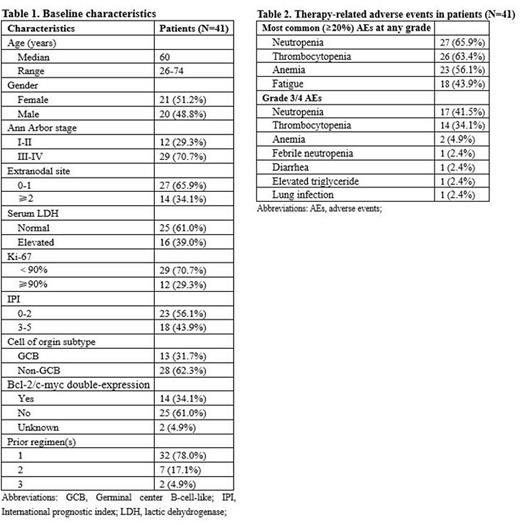Abstract
Background: The clinical outcomes remain significantly poor for patients with relapsed/refractory (R/R) diffuse large B-cell lymphoma (DLBCL), especially transplantation-ineligible R/R DLBCL. R-GemOx (rituximab, gemcitabine and oxaliplatin) is considered as one of the effective and acceptable side-effect therapeutic regimens for those patients. Chidamide, a histone deacetylase (HDAC) inhibitor, plays an anti-tumor effect by selectively inhibiting activity of HDAC1, 2, 3 and 10. Our preclinical finding indicated that chidamide combined with R-GemOx may have potential synergistic anti-tumor effect in DLBCL (unpublished data). Therefore, a prospective, multicenter, single-arm, phase II study (ClinicalTrials.gov: NCT04022005) was initiated to evaluate the efficacy and toxicity of chidamide in combination with R-GemOx (CR-GemOx) regimen for transplant-ineligible R/R DLBCL. Here, we reported the preliminary results of this ongoing study.
Methods: Patients aged 18-75 years with transplantation-ineligible R/R DLBCL who failed anthracycline-based chemotherapy were enrolled. The CR-GemOx regimen was administered as follows: chidamide, 20 mg, P.O., twice per week; rituximab 375mg/m2, d1, intravenous drip; gemcitabine 1000mg/m2, d2, intravenous drip; oxaliplatin 100mg/m2, d2, intravenous drip. Repeat cycle every 21 days (up to 6 cycles). Patients achieved complete response (CR) or partial response (PR) were administered chidamide as maintenance therapy. The primary endpoint was overall response rate (ORR). Secondary endpoints included duration of response, progression-free survival (PFS), overall survival (OS) and toxicities. The response was evaluated by using Lugano 2014 criteria. The safety was assessed according to Common Terminology Criteria for Adverse Events version 5.0.
Results: A total of 41 patients were enrolled between August 2019 and June 2022, including 26 patients (63.4%) with relapsed diseases and 15 patients (36.6%) with refractory diseases. The median age was 60 years (range: 26-74 years). Twenty patients were male (48.8%), and the median number of prior lines of therapy was 1 (range: 1-3). Baseline characteristics were listed in Table 1. All patients received response assessments, the ORR and CR rate were 61.0% and 31.7%, respectively. Notably, among 14 patients with bcl-2/c-myc double-expression (DE), 3 patients achieved CR (21.4%) and 5 patients had PR (35.7%). Sixteen patients received chidamide maintenance therapy. At the cut-off date of July 21st, 2022, the median PFS was 7.6 months (95% confidence interval: 2.7 - 12.5 months) with a median follow-up of 10.1 months. There were not significant differences in ORR (57.1% versus 64.0%, p=0.673) and median PFS (4.6 versus 12.4 months, p=0.079) between DE and non-DE patients. In the safety analysis population, the most common (≥20%) treatment-related adverse events (AEs) at any grade were neutropenia (65.9%, 27/41), thrombocytopenia (63.4%, 26/41), anemia (56.1%, 23/41), fatigue (43.9%, 18/41) (Table 2). Grade 3/4 AEs were neutropenia (41.5%, 17/41), thrombocytopenia (34.1%, 14/41), anemia (4.9%, 2/41), febrile neutropenia (2.4%, 1/41), diarrhea (2.4%, 1/41), and elevated triglyceride (2.4%, 1/41) (Table 2). Lung infection of grade ≥3 was observed in one patient only (2.4%, 1/41). Dose reductions of chidamide occurred in 13 patients due to AEs (thrombocytopenia, n=5; neutropenia, n=5; febrile neutropenia, n=1; diarrhea, n=2).
Conclusion: The CR-GemOx regimen demonstrates encouraging efficacy in transplant-ineligible R/R DLBCL patients. The common AEs at any grade and grade 3/4 were neutropenia, and thrombocytopenia. Furthermore, lone-term efficacy and safety evaluation in larger cohort is ongoing.
Disclosures
No relevant conflicts of interest to declare.
Author notes
Asterisk with author names denotes non-ASH members.


